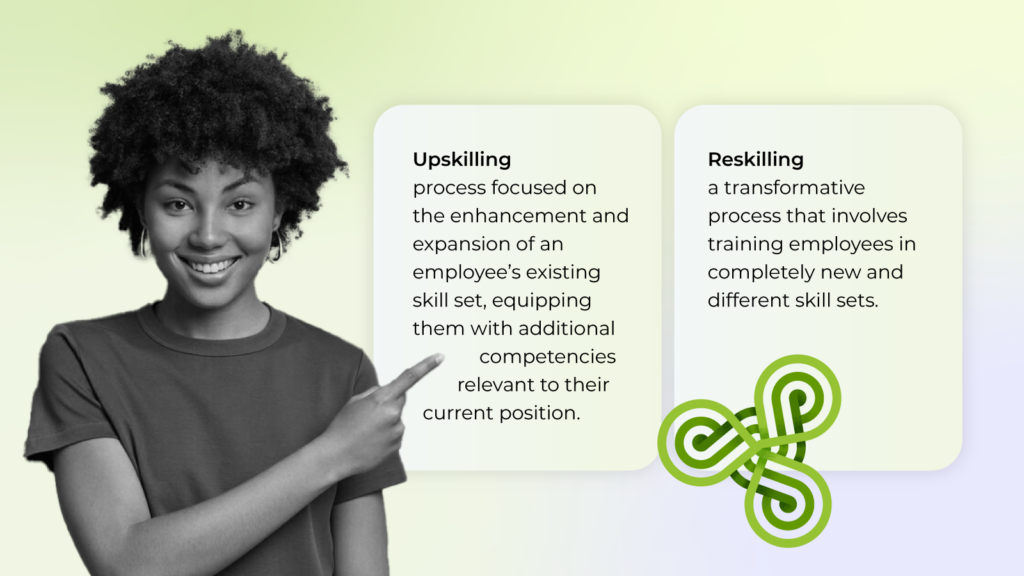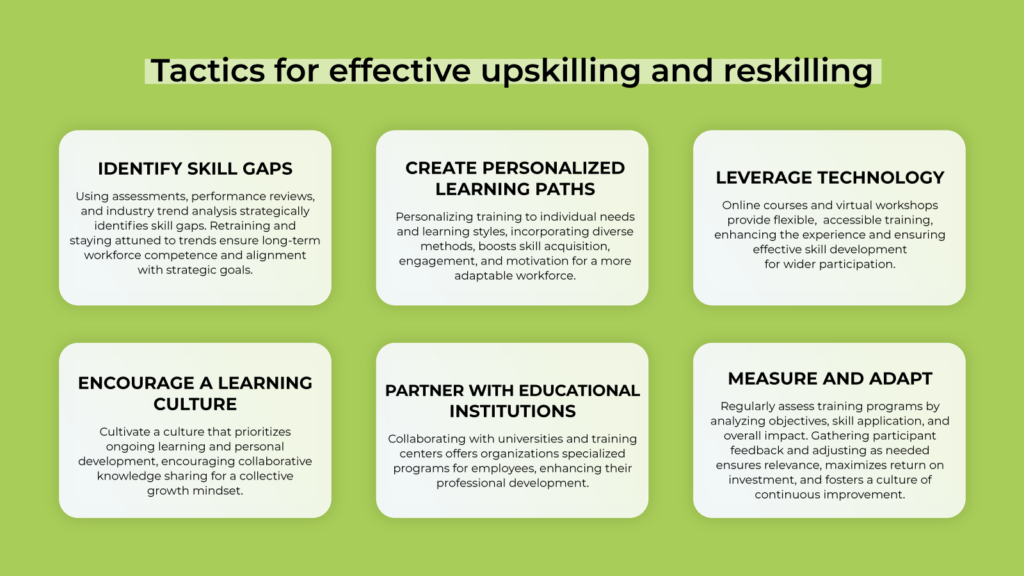
Upskilling and reskilling strategies to bridge the skills gap

There is a growing divergence between the skills that employees currently have and the ones they need for their job roles.
This emerging discrepancy, commonly referred to as the skill gap, represents a major obstacle for both businesses and their workforce.
As industries evolve with technological advancements and shifting market demands, the skills once deemed sufficient are now often found lacking.
A widening gap not only hinders individual career progression but also impacts the overall competitiveness and efficiency of organizations.

To effectively bridge this divide, companies must implement comprehensive strategies focused on upskilling and reskilling their employees.
Such strategies not only equip the workforce with relevant and up-to-date technical skills, but also prepare them to adapt to future changes and challenges in their respective industries.
Understanding the skill gap
The term “skill gap” refers to the discrepancy between the competencies that employers seek and the actual abilities that their workforce possesses.
This gap is increasingly prevalent due to the swift pace of technological innovation, the dynamic nature of market needs, and the evolving landscape of workplace practices.
These factors collectively contribute to a situation where the skills once considered adequate are no longer aligned with current or future job requirements. Gaining a clear understanding of the specific nature and magnitude of the skill gap within an organization is pivotal.
This initial step involves assessing current workforce capabilities against the backdrop of emerging industry trends and future projections.
Recognizing and quantifying this skills gap not only highlights areas in need of improvement but also sets the stage for crafting effective strategies to enhance employee skills, ensuring they meet the evolving demands of their roles and contribute effectively to the organization’s growth and adaptability.
The importance of upskilling and reskilling
Upskilling is a process focused on the enhancement and expansion of an employee’s existing skill set, equipping them with additional competencies relevant to their current position.
This approach is integral in ensuring that employees keep pace with the evolving demands of their roles, especially as technological and procedural advancements continuously reshape the work landscape.
Upskilling is not just about acquiring new skills; it’s about reinforcing and advancing existing skills required capabilities to enhance proficiency and efficiency in one’s current job.
In contrast, reskilling is a transformative process that involves training employees in completely new and different skill sets.
This strategy is essential for preparing employees for entirely different roles within the organization, often in response to shifts in business needs, restructuring, or technological advancements that render certain roles obsolete.
Reskilling is about adaptability and versatility, enabling employees to transition into different job roles or departments, thereby ensuring both their relevance and the organization’s resilience in the face of changing industry landscapes.
Both, upskilling strategies and reskilling are critical in a modern workplace. They not only empower employees with the skills necessary for career progression and job security but also help organizations to maintain a competitive edge by fostering a versatile and skilled workforce capable of adapting to new challenges and opportunities.
These practices are crucial for:
Maintaining a competitive edge
Organizations that boast a workforce well-versed in relevant skills stand at a significant advantage in adapting to the ever-changing market dynamics and technological innovations.
In today’s fast-paced business environment, the ability to quickly respond and adjust to new trends, technologies, and customer demands is crucial.
A skilled workforce not only adapts more efficiently but also capitalizes on these changes, turning potential challenges into opportunities for growth and innovation.

By fostering a culture of continuous learning and skill development, these organizations ensure that their employees are always at the forefront of industry advancements.
This proactive approach to workforce skill development is key to maintaining a competitive edge, driving business success, and securing long-term sustainability in an increasingly complex and unpredictable market.
Employee retention
Providing opportunities for professional development is a powerful strategy to enhance job satisfaction and foster employee loyalty. When employees are given the chance to grow their skills and advance in their careers, they often feel more valued and engaged in their work.
This sense of personal investment and accomplishment can lead to a more motivated and committed workforce. Additionally, when an organization demonstrates a commitment to its employees’ growth, it not only attracts but also retains top talent.
This is particularly important in today’s competitive job market, where career progression opportunities can be a deciding factor for many professionals.
Investing in employee growth not only benefits the individuals but also contributes to a positive workplace culture, improved employee morale, and ultimately, the overall success of the organization.
Cost efficiency
Retraining current employees to meet evolving job requirements is generally a more economical option compared to the process of recruiting and onboarding new talent. This cost-effectiveness stems from several factors.
Firstly, existing employees are already familiar with the company’s culture, systems, and processes, which reduces the time and resources needed for acclimatization. Secondly, the investment in retraining reinforces employee loyalty and reduces turnover costs, which are often significant when bringing in new staff.
Thirdly, by upskilling and reskilling employees, organizations can fill skill gaps more rapidly and efficiently, maintaining productivity without the downtime associated with external hiring processes.
Additionally, this approach signals to the workforce that the company values and invests in their career development, further boosting morale and commitment.
In the long run, the strategy of retraining existing employees not only saves costs but also strengthens the organization’s internal capabilities and employee relationships.
Tactics for effective upskilling and reskilling
Identify skill gaps
Leveraging employee assessments, performance reviews, and an analysis of prevailing industry trends is a strategic approach to pinpointing the precise skills that require enhancement within an organization. Employee assessments provide valuable insights into individual competencies and areas for improvement.
Performance reviews, on the other hand, offer a more comprehensive understanding of how these skills play out in actual work scenarios, highlighting strengths and weaknesses in current roles.
Additionally, keeping abreast of industry trends helps in anticipating future skill requirements, ensuring that the workforce is not only competent in their current roles but also prepared for upcoming changes and advancements in their field.
Integrating these tools creates a robust framework for identifying skill gaps and tailoring training programs that are both relevant and forward-thinking, aligning employee capabilities with the strategic goals of the organization.
Create personalized learning paths
Designing training programs to suit individual employee needs and learning styles is crucial for effective workforce development.
By incorporating diverse learning methods – like interactive modules, practical workshops, and digital learning – organizations can cater to various preferences, enhancing the learning experience.
This personalized approach not only boosts the efficacy of skill acquisition but also increases employee engagement and motivation, leading to a more skilled and adaptable workforce.
Leverage technology
Employing online courses, virtual workshops, and e-learning platforms offers flexible and accessible training options.
These digital resources enable employees to learn at their own pace and convenience, accommodating different schedules and learning preferences.
Such versatility not only enhances the training experience but also ensures wider participation and more effective skill development across the organization.
Encourage a learning culture
Cultivate a workplace culture that prioritizes ongoing learning and personal development. Encourage the sharing of knowledge and collaborative learning among peers.

This approach not only promotes a collective growth mindset but also fosters a collaborative atmosphere where employees can learn from each other’s experiences, key skills and insights.
Partner with educational institutions
Partnering with universities and vocational training centers enables organizations to access specialized training programs.
This collaboration provides employees with expert-led learning opportunities, tailored to specific industry needs, expertise and skill sets, enhancing their professional development.
Measure and adapt
It’s crucial for organizations to regularly assess the effectiveness of their training programs.
This ongoing evaluation involves analyzing how well the training meets its objectives, the extent to which employees are applying new skills in their work, and the overall impact on performance and productivity.
Gathering feedback from participants, monitoring key performance indicators, and comparing pre- and post-training metrics are effective ways to gauge the success of these programs.
Based on these insights, necessary adjustments can be made, ensuring that the training remains relevant, addresses any identified gaps, and continues to align with both the evolving needs of the organization and the professional development of its employees.
This iterative process not only maximizes the return on investment in training but also fosters a culture of continuous improvement and learning.
Conclusion
Bridging the skill gap through upskilling and reskilling is not just a response to a growing challenge; it’s a proactive strategy to empower employees and ensure the long-term success of an organization.
By adopting comprehensive and tailored approaches, businesses can turn skill gaps into opportunities for growth and innovation.




